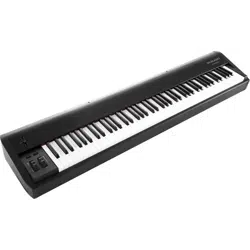Loading ...
Loading ...
Loading ...

22
Keybed & Zones
The keybed (the piano keys) on your Hammer 88 can be divided into 1–4 “zones.” When a zone is active (i.e., when
its checkbox is checked), it can send its controls’ MIDI messages over its own MIDI channel. Zones are independent
and can overlap each other, as well.
Tip: This feature is great for dividing your Hammer 88 between different virtual instruments or synthesizers. For
example, you can create two zones, each using a different MIDI channel, and play and control two virtual instruments
simultaneously—one with each half of the keys.
Click each of the Zone 1–4 checkboxes to enable or disable each zone. Use each zone’s parameters to set the MIDI
assignments for it on your Hammer 88. All 4 zones have the same parameters, which operate independently.
Note: If any keys on the keybed are not assigned to a zone, they will continue to send their messages over the
global MIDI channel and use the Octave and Transpose menu settings above the Zone checkboxes.
Note: Each zone’s Octave and Transposition settings are independent from the keybed’s Octave and Transposition,
but all of these affect the note that a key sends out.
These are the available parameters for the entire keybed, which work in conjunction with any zone settings:
Octave: The keybed will send its notes using this octave shift (from its original position on the keybed) (-6 to +6).
Transpose: The keybed will send its notes using this transposition (from its original position on the keybed) (-12
to +12).
Velocity Curve: This setting determines how much force is required to generate a note with a specific velocity:
• Hard: The keybed will require a lot of force to generate high-velocity notes. This is the default setting as
it creates the most realistic “feel” for a hammer-action keyboard like Hammer 88.
• Soft 1 & Soft 2: The keybed will require little force to generate high-velocity notes. Use one of these
settings if you want to play high-velocity notes more easily.
• Linear: This is a straight “linear curve”—the note generated will always be proportional to the amount of
force used.
• Fixed 64, Fixed 100 & Fixed 127: These settings “lock” all notes at a single velocity, regardless of how
much force you use to play them. 127 is the maximum velocity. 64 is considered half-velocity.
These are the available parameters for each zone:
Chan: The zone will send its messages over this channel. Select the global channel (Global) or a specific channel
(Channel 1–16).
First: This will be the lowest key of that zone (1/A0 – 88/C8).
Last: This will be the highest key of that zone (1/A0 – 88/C8).
Octave: The zone’s keys will send their notes using this octave shift (from their original position on the keybed) (-6
to +6).
Transpose: The zone’s keys will send their notes using this transposition (from their original position on the keybed)
(-12 to +12).
Loading ...
Loading ...
Loading ...
